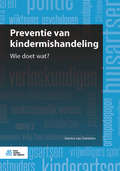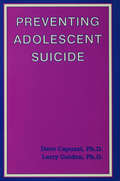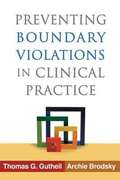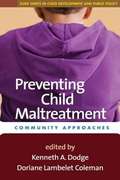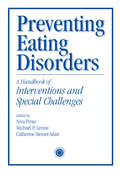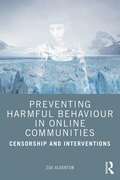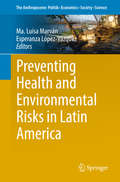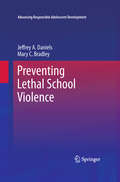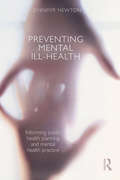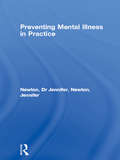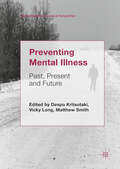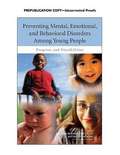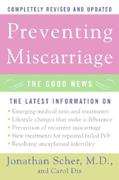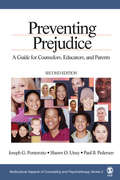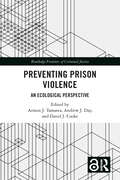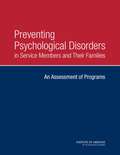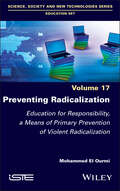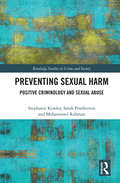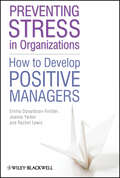- Table View
- List View
Preventie van kindermishandeling: Wie doet wat?
by Sandra Van GamerenDit boek geeft iedereen die met ouders of kinderen omgaat, inzicht in de theorie over en praktijk van de preventie van kindermishandeling. Het boek is geschikt voor behandelaars, wijkteams, beleidsmakers, leerkrachten, verloskundigen, CJG-medewerkers, kraamverzorgenden en omstanders. Zij hebben allemaal een verantwoordelijkheid in de preventie van kindermishandeling. In Preventie van kindermishandeling. Wie doet wat? staan interviews met beroepskrachten die vanuit verschillende disciplines de praktijk of theorie verhelderen. Omdat het thema veel vragen oproept, heeft het boek een onderzoekende opzet. Is een complex probleem als kindermishandeling te voorkomen? Door wie? Wat gebeurt er al op het gebied van preventie? Waarom blijven de cijfers alarmerend hoog? Deze en andere vragen komen in dit boek uitgebreid aan bod.Drs. Sandra van Gameren is gezondheidspsycholoog. Ze houdt zich voornamelijk bezig het met het voorkomen van geestelijke gezondheidsklachten en komt op voor kinderen in nood. Van Gameren werkt bij Stichting Kinderbelang en Transparant Training. Ze is auteur vanLeven met een psychisch zieke ouder, dat eerder verscheen bij BSL.
Preventieve cognitieve training bij terugkerende depressie (Protocollen voor de GGZ)
by Claudi BocktingPreventieve cognitieve training bij terugkerende depressie is een protocol voor psychologen, psychotherapeuten, psychiaters en andere hulpverleners in de geestelijke gezondheidszorg gericht op het voorkomen van terugval bij cliënten die hersteld zijn van voorgaande depressies.Het protocol is gebaseerd op cognitief therapeutische principes en is effectief in het voorkomen van terugval bij mensen met veel voorgaande depressieve episodes. De nadruk ligt op wat de cliënt zelf kan doen om terugval te voorkomen waarbij veel aandacht besteed wordt aan denkpatronen. De training resulteert in een preventieplan voor cliënten. Dit protocol is bedoeld voor psychologen, psychotherapeuten, psychiaters en andere hulpverleners in de geestelijke gezondheidszorg.'Niet meer depressief'(isbn 9789031374274) is het bijbehorende werkboek voor cliënten. Het bevat informatie, formulieren en uitleg die de cliënt tijdens de behandeling nodig heeft. Het werkboek is gebaseerd op cognitief therapeutische uitgangspunten en is effectief gebleken in het voorkomen van een volgende depressie.Preventieve cognitieve training bij terugkerende depressie is onderdeel van de reeks Protocollen voor de GGZ. Elk deel geeft een sessiegewijze omschrijving van de behandeling van een specifieke psychische aandoening weer en bevat een dvd met beelden van therapiesessies. De theorie is beknopt en berust op wetenschappelijke evidentie. Protocollen voor de GGZ is bedoeld voor psychologen, psychotherapeuten, psychiaters en andere hulpverleners.
Preventing Adolescent Depression and Suicide Among Latinas
by Andrea J. Romero Lisa M. Edwards Sheri Bauman Marissa K. RitterSince the 1960s, in comparison to other ethnic and gender groups, a higher rate of depression and suicide ideation has been documented for Latina girls. This Brief offers a concise summary of contemporary research on this critical topic. Among the considerations are the influence of bullying, families, immigration, and culture on Latina adolescent mental health. Presenting cutting-edge multiracial feminist frameworks for new and existing empirical findings, this book serves to guide the future research agenda on this topic. Clinical recommendations are also included.
Preventing Adolescent Suicide
by Dave Capuzzi Larry GoldenFirst published in 1988. Many people absolutely reject suicide under any circumstances. However. most of us can sympathize with the suicidal motives. let's say. of an elderly person afflicted with terminal cancer. But it disturbs the core of our being that a child would find this life so empty of hope that death would be preferable. Teenagers are so full of pain. pleasure. sexuality. energy. curiosity. idealism. bravado. vulnerability. rebellion. and promise! This book comes to grips with the reality of adolescent suicide. In the book are fifteen chapters organized under five major parts.
Preventing Aids: A Sourcebook for Behavioral Interventions
by Seth C. KalichmanThis book provides a comprehensive overview of behavioral interventions to prevent HIV-AIDS risk-related behaviors. It synthesizes the empirical literature on individual, group, and community-level interventions and provides an objective and detailed assessment of intervention outcomes. Factors associated with behavioral risk for HIV transmission, theories of HIV risk behavior change, and the state of HIV prevention technology transfer are also reviewed. Additionally, behavioral interventions for adolescents and adults of diverse ethnic and sexual backgrounds are discussed with respect to each intervention type. Although the focus is on sexual risk reduction, interventions for sexual behavior of substance abusing populations are also covered.
Preventing Boundary Violations in Clinical Practice
by Thomas G. Gutheil Archie BrodskyWhat do you do when you run into a patient in a public place? How do you respond when a patient suddenly hugs you at the end of a session? Do you accept a gift that a patient brings to make up for causing you some inconvenience? Questions like these which virtually all clinicians face at one time or another have serious clinical, ethical, and legal implications. This authoritative, practical book uses compelling case vignettes to show how a wide range of boundary questions arise and can be responsibly resolved as part of the process of therapy. Coverage includes role reversal, gifts, self-disclosure, out-of-office encounters, physical contact, and sexual misconduct. Strategies for preventing boundary violations and managing associated legal risks are highlighted.
Preventing Child Maltreatment
by Doriane Coleman Kenneth DodgeMany child abuse prevention programs have targeted factors within the family, such as parenting skills. This book describes the next wave of prevention the promotion of safer, healthier childrearing environments in entire communities. The contributors are leading authorities who illuminate how contextual factors including poverty, chaotic neighborhoods, and lack of social supports combine with family factors to place children at risk for maltreatment. They present a range of exemplary programs designed to strengthen communities while also helping individual parents to meet their children's needs. Real-world evaluation approaches, quality-control strategies, and policy implications are discussed in depth.
Preventing Drunk Driving
by Joseph R Ferrari Elsie ShorePreventing Drunk Driving shows what is being done today, in research and practice, to reduce impaired driving and the fatalities and injuries it produces and to curtail the spread of this tragic social epidemic. In this informative book, you’ll discover how current research and prevention programs are increasing the success of designated driver programs. You’ll also find out how communities, friends, and experts are making drinkers aware of their levels of intoxication and discouraging them from driving to keep the roads safer. You’ll see when intervention works, when it doesn’t, and how you can be most effective as a citizen in the fight against impaired driving deaths along your own stretch of the world’s highways and city streets. In Preventing Drunk Driving, you’ll get up-to-date data on how researchers are identifying the most dangerous drunk driving recidivists. Also, you’ll see how increased study and research have led to theoretical models of intervention, assessments of the usefulness of vehicle interlock programs, and the use of mapping to target offenders most at risk. Most importantly, you’ll learn: the results of experiments designed to test methods of increasing designated driving how census-tract mapping can target communities prone to DWI offenses the benefits and limitations of vehicle-interlock devices for the prevention of recidivism how interveners may improve their chances of stopping an impaired person from getting behind the wheel ways that blood alcohol concentration (BAC) feedback stations can reduce DUI incidents“Give me the keys.” “Friends don’t let friends drive drunk.” These are all sayings we’ve heard--but what are the scientific facts about impaired driving and its prevention in our local communities and neighborhoods? Preventing Drunk Driving analyzes the societal ill of driving under the influence of alcohol and its related death toll from a wide variety of angles.
Preventing Eating Disorders: A Handbook of Interventions and Special Challenges (Sickkids Community And Mental Health Ser. #2)
by Michael P. Levine Catherine Steiner-Adair Niva PiranThis comprehensive resource provides multiple prevention strategies, programs, and approaches for health and mental health workers, educators, researchers, students, and interested members of the community at large who work to prevent eating disorders and related problems.
Preventing Harmful Behaviour in Online Communities: Censorship and Interventions
by Zoe AldertonPreventing Harmful Behaviour in Online Communities explores the ethics and logistics of censoring problematic communications online that might encourage a person to engage in harmful behaviour. Using an approach based on theories of digital rhetoric and close primary source analysis, Zoe Alderton draws on group dynamics research in relation to the way in which some online communities foster negative and destructive ideas, encouraging community members to engage in practices including self-harm, disordered eating, and suicide. This book offers insight into the dangerous gap between the clinical community and caregivers versus the pro-anorexia and pro-self-harm communities – allowing caregivers or medical professionals to understand hidden online communities young people in their care may be part of. It delves into the often-unanticipated needs of those who band together to resist the healthcare community, suggesting practical ways to address their concerns and encourage healing. Chapters investigate the alarming ease with which ideas of self-harm can infect people through personal contact, community unease, or even fiction and song and the potential of the internet to transmit self-harmful ideas across countries and even periods of time. The book also outlines the real nature of harm-based communities online, examining both their appeal and dangers, while also examining self-censorship and intervention methods for dealing with harmful content online. Rather than pointing to punishment or censorship as best practice, the book offers constructive guidelines that outline a more holistic approach based on the validity of expressing negative mood and the creation of safe peer support networks, making it ideal reading for professionals protecting vulnerable people, as well as students and academics in psychology, mental health, and social care.
Preventing Health and Environmental Risks in Latin America
by Ma. Luisa Marván Esperanza López-VázquezThis book addresses environmental and medical issues that could risk our well-being, our health, or even cause death. Some of the issues analysed could have negative consequences not only today but also for future generations if not prevented in time. With regard to health risks, the authors discuss several diseases that could be avoided if people perform (or avoid) certain behaviours and become accustomed to having healthier habits. Concerning environmental hazards, the authors discuss which social groups should be taken into account based on preventive strategies used to avoid a particular disaster. Both sections of the book on health and environmental issues have a subsection with chapters about risks and society. No matter the risk-related discipline the reader is familiar with, when he ends reading the book, it will become clear that risk analysis is the basis for prevention, and that it cannot be addressed from a single discipline nor with a single methodology.
Preventing Lethal School Violence
by Jeffrey A. Daniels Mary C. BradleyBullying. Gang assaults. Rampage shootings. School violence, especially when it turns deadly, has enduring social and psychological effects on students, faculty, staff, and the community. And though a great deal of research focuses on the significant role children's positive social development plays in reducing incidents of school violence, in-depth examinations of evidence-based preventive measures have remained minimal until now. With its focus on averting lethal school violence, this unique volume translates the prosocial findings into practicable preventive measures that can be put to use in school settings. Making expert use of news reports as well as scholarly data, Preventing Lethal School Violence clarifies the links between bullying and lethal violence and delineates typical characteristics of school shooters while cautioning against outright profiling. Students' awareness of self and others, strong connections with adults, and other social and ethical skills form the basis of a comprehensive, research-based model for reducingâ "and potentially eliminatingâ "lethal incidents at school. This accessible volume: Outlines the scope of school violence as a broader social problem. Summarizes current information on the traits common to students who commit lethal violence at school. Examines the relationship between bullying/cyberbullying and rampage incidents. Analyzes examples of successful prevention of violent acts and resolution of hostage situations. Describes in detail the concept of positive school climate and introduces the Safe School Communities Model. Synthesizes key research data into violence prevention skills for students, teachers, administrators, and all professionals working in schools. Preventing Lethal School Violence is a must-have resource for researchers and professionals in school psychology and allied education disciplines, including school administration, school counseling, and social work.
Preventing Mental Ill-Health: Informing public health planning and mental health practice
by Jennifer NewtonIs there any evidence that we can reduce the incidence of mental ill health? Is it possible to prevent recurrence of mental ill health? Aspirations to achieve both these goals have featured in mental health policy and practice for over 100 years. This comprehensive and accessible book draws on research on the development and persistence of behavioural problems in childhood, adult depression and schizophrenia. The association between social disadvantage and mental ill health, as well as the need for preventive care to start from conception and the crucial importance of maternal mental health, are discussed. A variety of prominent programmes which have good evidence of efficacy are described. These include: Targeted approaches with individuals and families Macro policies affecting housing and employment Lifestyle contributions such as diet and exercise However, some attempts to achieve preventive benefits have not succeeded, and reflecting on these problems is an important feature of this review. Jennifer Newton has written extensively on these issues for over twenty years, and her careful examination of the research literature provides a succinct overview of the state of current knowledge which will benefit mental health professionals, and students of health psychology and public health. It also takes a life course perspective, and considers how, when and why vulnerability persists through childhood into adult life, so will interest those whose work focuses on child well-being.
Preventing Mental Illness in Practice
by Jennifer Newton Dr Jennifer NewtonIn this follow up to Preventing Mental Illness, Jennifer Newton describes real life examples of good practice in preventive mental health. Five areas covering the life span have been identified and promising strategies are described in detail: what is provided, how the target group is engaged, the resources required, management problems and evidence of effectiveness. Interviews with both clients and providers help to bring to life the descriptions as we learn how the support came to be needed and what benefits they themselves feel have been reaped. These descriptive studies, together with criteria for judging the efficacy of interventions, provide an excellent resource for planners and policy makers. The book will also be invaluable to those who seek to implement preventive policies in their day to day work - lives - such as social workers, clinical psychologists, health visitors, community psychiatric nurses and general practitioners.
Preventing Mental Illness: Past, Present and Future (Mental Health in Historical Perspective)
by Matthew Smith Vicky Long Despo KritsotakiThis book provides an overview of a diverse array of preventive strategies relating to mental illness, and identifies their achievements and shortcomings. The chapters in this collection illustrate how researchers, clinicians and policy makers drew inspiration from divergent fields of knowledge and practice: from eugenics, genetics and medication to mental hygiene, child guidance, social welfare, public health and education; from risk management to radical and social psychiatry, architectural design and environmental psychology. It highlights the shifting patterns of biological, social and psychodynamic models, while adopting a gender perspective and considering professional developments as well as changing social and legal contexts, including deinstitutionalisation and social movements. Through vigorous research, the contributors demonstrate that preventive approaches to mental health have a long history, and point to the conclusion that it might well be possible to learn from such historical attempts. The book also explores which of these approaches are worth considering in future and which are best confined to the past. Within this context, the book aims at stoking and informing debate and conversation about how to prevent mental illness and improve mental health in the years to come.Chapters 3, 10, and 12 of this book are available open access under a CC BY 4.0 license at link.springer.com
Preventing Mental, Emotional, and Behavioral Disorders Among Young People: Progress and Possibilities
by National Research Council Institute of Medicien of the National AcademiesFor multi-user PDF licensing, please contact mailto:customer_service@nap.edu customer service. Mental health and substance use disorders among children, youth, and young adults are major threats to the health and well-being of younger populations which often carryover into adulthood. The costs of treatment for mental health and addictive disorders, which create an enormous burden on the affected individuals, their families, and society, have stimulated increasing interest in prevention practices that can impede the onset or reduce the severity of the disorders. Prevention practices have emerged in a variety of settings, including programs for selected at-risk populations (such as children and youth in the child welfare system), school-based interventions, interventions in primary care settings, and community services designed to address a broad array of mental health needs and populations. Preventing Mental, Emotional, and Behavioral Disorders Among Young People updates a 1994 Institute of Medicine book, Reducing Risks for Mental Disorders, focusing special attention on the research base and program experience with younger populations that have emerged since that time. Researchers, such as those involved in prevention science, mental health, education, substance abuse, juvenile justice, health, child and youth development, as well as policy makers involved in state and local mental health, substance abuse, welfare, education, and justice will depend on this updated information on the status of research and suggested directions for the field of mental health and prevention of disorders.
Preventing Miscarriage: the Good News
by Jonathan Scher Carol DixA Reassuring and Informative Guide That Offers New Hope For Expectant Parents Along with inspiring accounts of women who have delivered healthy babies after years of heartbreak. Dr. Jonathan Scher provides the latest medical information on preventing recurrent miscarriages, including why couples with "unexplained infertility" actually may be suffering repeat pregnancy loss due to failure of the embryo to implant in the womb, important immunological and tissue tests that may explain or prevent miscarriage, emerging treatments such as heparin and I.V.I.G., updated resources, and much more.
Preventing Prejudice: A Guide for Counselors, Educators, and Parents
by Paul B. Pedersen Professor Joseph G. Ponterotto Dr Shawn O. UtseyThe Second Edition of Preventing Prejudice: A Guide for Counselors, Educators, and Parents has been completely revised and expanded to provide the most up-to-date and extensive coverage of prejudice and racism available. The new edition of this bestselling text presents a comprehensive overview of these topics and also includes practical tools for combating prejudice development in children, adolescents, and adults.
Preventing Prison Violence: An Ecological Perspective (Routledge Frontiers of Criminal Justice)
by Armon J. Tamatea Andrew J. Day David J. CookePreventing Prison Violence introduces the idea of ‘prison ecologies’ – a multi-layered perspective to understanding prison violence as a ‘product’ of human, environment (social and physical), systemic, and societal influences – and how an ecological approach is helpful to prevention efforts.Interpersonal violence is a global concern and a significant cause of death around the world. In prisons, the human, financial, and health burden of violence presents a significant social issue – as well as a ‘wicked problem’ that does not permit of simplistic solutions. Recent innovations in data capture means that questions about violence, gang-affiliations, and prisons that could not be answered previously can now be explored. The central theme of this book is that prisons are ‘ecologies’ – spaces where people, resources, and the built environment are interrelated – and that violence is a product of a complex of interpersonal and environmental factors that increase the likelihood of assault – but also provide opportunities for solutions. Drawing on psychology, geography, indigenous knowledge, gang culture, and predictive modelling, this book expands beyond the conventional individual-focused ‘assessment-intervention-prevention’ approach to research in this field, towards a holistic and ecological way of thinking that recognises individual, organisational, and cultural factors, as well as the role of the physical environment itself in the facilitation and prohibition of aggression.Providing a comprehensive resource for those who are interested in making prisons safer; firmly based in contemporary research and theory, Preventing Prison Violence will be of great interest to students and scholars of Penology, Violence and Forensic Psychology, as well as to professionals working in criminal justice settings.The Open Access version of this book, available at http://www.taylorfrancis.com, has been made available under a Creative Commons [Attribution-Non Commercial-No Derivatives (CC BY-NC-ND)] 4.0 license.
Preventing Prison Violence: An Ecological Perspective (Routledge Frontiers of Criminal Justice)
by Armon J. Tamatea, Andrew J. Day, and David J. CookePreventing Prison Violence introduces the idea of ‘prison ecologies’ – a multi-layered perspective to understanding prison violence as a ‘product’ of human, environment (social and physical), systemic, and societal influences – and how an ecological approach is helpful to prevention efforts. Interpersonal violence is a global concern and a significant cause of death around the world. In prisons, the human, financial, and health burden of violence presents a significant social issue – as well as a ‘wicked problem’ that does not permit of simplistic solutions. Recent innovations in data capture means that questions about violence, gang-affiliations, and prisons that could not be answered previously can now be explored. The central theme of this book is that prisons are ‘ecologies’ – spaces where people, resources, and the built environment are interrelated – and that violence is a product of a complex of interpersonal and environmental factors that increase the likelihood of assault – but also provide opportunities for solutions. Drawing on psychology, geography, indigenous knowledge, gang culture, and predictive modelling, this book expands beyond the conventional individual-focused ‘assessment-intervention-prevention’ approach to research in this field, towards a holistic and ecological way of thinking that recognises individual, organisational, and cultural factors, as well as the role of the physical environment itself in the facilitation and prohibition of aggression. Providing a comprehensive resource for those who are interested in making prisons safer; firmly based in contemporary research and theory, Preventing Prison Violence will be of great interest to students and scholars of Penology, Violence and Forensic Psychology, as well as to professionals working in criminal justice settings.
Preventing Psychological Disorders in Service Members and Their Families: An Assessment of Programs
by Laura Aiuppa DenningBeing deployed to a war zone can result in numerous adverse psychological health conditions. It is well documented in the literature that there are high rates of psychological disorders among military personnel serving in Operation Enduring Freedom in Afghanistan and Operation Iraqi Freedom in Iraq as well as among the service members' families. For service members' families, the degree of hardship and negative consequences rises with the amount of the service members' exposure to traumatic or life-altering experiences. Adult and child members of the families of service members who experience wartime deployments have been found to be at increased risk for symptoms of psychological disorders and to be more likely to use mental health services. In an effort to provide early recognition and early intervention that meet the psychological health needs of service members and their families, DOD currently screens for many of these conditions at numerous points during the military life cycle, and it is implementing structural interventions that support the improved integration of military line personnel, non-medical caregivers, and clinicians, such as RESPECT-Mil (Re-engineering Systems of Primary Care Treatment in the Military), embedded mental health providers, and the Patient-Centered Medical Home. "Preventing Psychological Disorders in Service Members and Their Families" evaluates risk and protective factors in military and family populations and suggests that prevention strategies are needed at multiple levels - individual, interpersonal, institutional, community, and societal - in order to address the influence that these factors have on psychological health. This report reviews and critiques reintegration programs and prevention strategies for PTSD, depression, recovery support, and prevention of substance abuse, suicide, and interpersonal violence.
Preventing Radicalization: Education for Responsibility, a Means of Primary Prevention of Violent Radicalization (ISTE Invoiced)
by Mohammed El OurmiFaced with the growing and persistent threat of radicalization, both in France and worldwide, it is crucial to explore new approaches to prevention. Preventing Radicalization proposes an innovative method for understanding and preventing violent radicalization, focusing on the development of individual responsibility through the enhancement of psychosocial skills. It examines the limits of traditional approaches centered on security and justice, and proposes concrete, innovative strategies focused on the search for solutions, notably through educational and awareness-raising programs. This integrated, humanistic approach, which aims to strengthen epistemic, emotional, attentional, relational and axiological skills, represents a significant advance in the primary prevention of violent radicalization processes. In a context where radicalization continues to threaten the stability of societies, it is imperative to rethink prevention strategies. This book provides the essential keys to understanding this complex threat for all those who wish to tackle it.
Preventing Sexual Harm: Positive Criminology and Sexual Abuse (Routledge Studies in Crime and Society)
by Mohammed Rahman Stephanie Kewley Sarah PembertonPreventing Sexual Harm provides an overview of current criminal justice strategies to tackling sexual violence, and highlights existing positive criminological approaches that could help prevent sexual abuse and harm. Sexual violence is a complex, multi-faceted crime. Its causes and consequences are both multiple and enduring and our understanding of sexual violence is embedded within our social, cultural and political constructs. As such, a response to sexual violence ought to be equally as complex and multi-faceted. Alternative approaches might therefore be needed, such as Positive Criminology. In response, this book explores Positive Criminology as a mechanism to reduce the risk of recidivism, eradicate harm, prevent re-offending as well as helping to reintegrate those with histories of sexual abuse back into the community. In light of recent historical cases of sexual abuse and poor institutional response to these allegations, it opens with an overview of the current landscape of sexual offending. The book then reviews the current positive criminological approaches already in existence in the effort to prevent sexual abuse, outlining the approach of Positive Criminology and demonstrating the many gaps in practice that might benefit from this new way of working to prevent sexual abuse. Highlighting that an alternative response to sexual violence is needed, and presenting the idea that a positive criminological paradigm is worthy of further examination, this book will be of great interest to scholars of criminology, criminal justice and forensic psychology.
Preventing Stress in Organizations
by Rachel Lewis Emma Donaldson-Feilder Joanna YarkerPreventing Stress in Organizations:How to Develop Positive Managersoffers an innovative, evidence-based approach to help managers prevent and reduce workplace stress in their staff.Winner of the 2013 BPS Book Award - Practitioner Text categoryProvides information on the critical skills managers must develop in order to prevent stress in their staff, and the key ongoing behaviours that promote a healthy work environmentShows practitioners in occupational psychology, HR, Health and Safety and related professions how positive management can be integrated into an organizationâ TMs existing practices and processesServes as an essential guide for managers themselves on how to incorporate proven stress management skills into their everyday interactions with team membersBalances rigorous research grounding with real-world vignettes, case studies and exercises
